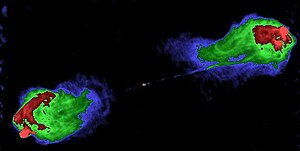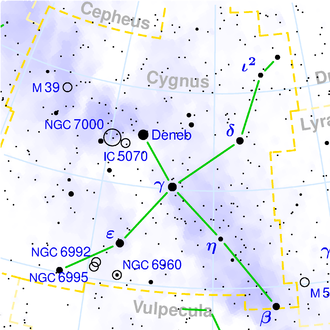Cygnus A
| Galaxy Cygnus A |
|
|---|---|

|
|
| False color radio image at 5 GHz (data from VLA ) | |
| AladinLite | |
| Constellation | swan |
|
Position equinox : J2000.0 , epoch : J2000.0 |
|
| Right ascension | 19 h 59 m 28.4 s |
| declination | + 40 ° 44 ′ 02.1 ″ |
| Appearance | |
| Morphological type | E. |
| Angular expansion | 0 ′, 5 |
| Physical data | |
| Affiliation | Cygnus A cluster |
| Redshift | 0.056075 ± 0.000067 |
| distance | approx. 750 million ly / approx. 230 million pc |
| history | |
| discovery | Big Reber |
| Discovery date | 1939 |
| Catalog names | |
| PGC 63932 • MCG + 07-41-003 • IRAS 19577 + 4035 • 4C 40.40 • VV 72 • 2E 4309 • W 57 • BWE 1957 + 4035 • NRAO 620 • 1C 19.01 • QSO B1957 + 405 • 3C 405 • 1RXS J195928. 7 + 404405 • 2U 1957 + 40 • 4U 1957 + 40 • DA 500 • DB 117 • Mills 19 + 4 | |
Cygnus A ( 3C 405) is one of the brightest and most famous radio galaxies . The object was discovered in 1939 by Grote Reber ; as a collection of discrete objects it was identified by James Stanley Hey and colleagues in England in 1946 and in 1953 Roger Jennison and Mrinal Kumar Das Gupta were able to show that it was a double source. Like all other radio galaxies, this one also contains an active galaxy core .
Images of the radio emissions from astronomy show two jets leaving the center of the galaxy in opposite directions and whose expansion is a multiple of the expansion of the galaxy itself, which can be detected in the range of visible light . The jets end in areas of very hot gas, which are clearly detectable by their radio radiation. Here the jet particles meet the intergalactic medium surrounding the galaxy , which is heated up strongly in the process.
literature
- Harris, DE; Carilli, CL; Perley, RA: X-Ray Emission from the Radio Hotspots of Cygnus-A , Nature Vol. 367, p. 713, 1994 bibcode : 1994Natur.367..713H
- Blanco, Philip: The powerful radio galaxy Cygnus A . February 7, 1997. Retrieved October 9, 2017.
Individual evidence
- ↑ SIMBAD
- ↑ NASA / IPAC Extragalactic Database
- ↑ Jennison, RC; Das Gupta, MK: Fine Structure of the extra-terrestrial radio source Cygnus 1 . In: Nature, Vol. 172 . 1953, p. 996. bibcode : 1953Natur.172..996J .
- ^ Strange, D: The Radio Galaxy Cygnus "A" . Archived from the original on February 21, 1999. Retrieved September 22, 2008.
- ↑ X-Ray Cygnus A - Astronomy Picture of the Day of October 5, 2002 (English). Retrieved December 30, 2009
